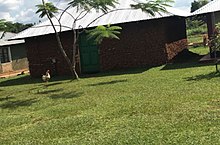
Luhya people
Number of ethnic groups in Kenya / From Wikipedia, the free encyclopedia
Dear Wikiwand AI, let's keep it short by simply answering these key questions:
Can you list the top facts and stats about Luhya people?
Summarize this article for a 10 years old
The Luhya (also known as Abaluyia or Luyia) are a bantu people and the second largest ethnic group in Kenya. The Luhya belong to the larger linguistic stock known as the Bantu. The Luhya are located in western Kenya and Uganda. They are divided into 20 (or 21, when the Suba are included) culturally and linguistically united clans. Once known as the Bantu Kavirondo, multiple small tribes in North Nyanza came together under the new name Baluhya between 1950 and 1960.Bukusu is the largest luhya subtribe and account almost 50% of entire luhya population. They dominates other luhya small subtribes and they live in both Bungoma and Trans nzoia counties[2]
| Total population | |
|---|---|
| Kenya: 6,823,482 (2019)[1] | |
| Regions with significant populations | |
| Kenya, Uganda, Tanzania | |
| Languages | |
| Luhya | |
| Religion | |
| Christianity, African Traditional Religion | |
| Related ethnic groups | |
| Masaba people and other Great Lakes Bantu People |
| Person | OmuLuyia |
|---|---|
| People | AbaLuyia |
| Language | OluLuyia |
| Country | EbuLuyia |
The Luhya culture is similar to the Great Lakes region Bantu speakers. During a wave of expansion that began 4,000 to 5,000 years ago, Bantu-speaking populations – as of 2023, some 310 million people – gradually left their original homeland of West-Central Africa and traveled to the eastern and southern regions of the continent. Using data from a vast genomic analysis of more than 2,000 samples taken from individuals in 57 populations throughout Sub-Saharan Africa, scientists from the Institut Pasteur and the CNRS, together with a broad international consortium, have retraced the migratory routes of these populations, previously a source of debate.[3]
Luhya today refers to both the 21 Luhya clans and their respective Luhya dialects. There are 21 clans that make up the Luhya. The Luhya belong to the larger linguistic stock known as the Bantu. The Luhya comprise several subgroups with different but mutually understood linguistic dialects.[4] The word “Luhya" or “Luyia" in some of the dialects means "the north.” There is no single Luhya language. Rather, there are several mutually understood dialects that are principally Bantu. Perhaps the most identifying linguistic feature of the various Luhya dialects is the use of the prefix aba- or ava-, meaning "of" or "belonging to." Thus, for example, "Abaluhya (Abaluyia)" means "people from the north." Other translations are "those of the same hearth.”[5]
The 21 clans are the Bukusu (Aba-Bukusu), Idakho (Av-Idakho), Isukha (Av-Isukha), Kabras (Aba-Kabras), Khayo (Aba-Khayo), Kisa (Aba-Kisa), Marachi (Aba-Marachi), Maragoli (Aba-Logoli), Marama (Aba-Marama), Nyala (Aba-Nyala), Nyole (Aba-Nyole), Samia (Aba-Samia), Tachoni (Aba-Tachoni), Tiriki (Aba-Tiriki), Tsotso (Abatsotso), Wanga (Aba-Wanga), and Batura (Abatura) and the Abasiaya. They are closely related to the Masaba (or Gisu), Basamia and Banyole of Uganda, whose language is mutually intelligible with Luhya. The Bukusu and the Maragoli are the two largest Luhya clans.

The principal traditional settlement area of the Luhya is in what was formerly the Western province. A substantial number of them permanently settled in the Kitale and Kapsabet areas of the former Rift Valley province. The Luhya people make their home mainly in the western part of Kenya. Administratively, they occupy mostly Western province, and the west-central part of Rift Valley province. Luhya migration into the Rift Valley is relatively recent, only dating back to the first few years after independence in 1963, when farms formerly occupied by colonial white settlers were bought by, or given to Africans.[6] Western Kenya is one of the most densely populated parts of Kenya.[7] Migration to their present Luhyaland (a term of endearment referring to the Luhya's primary place of settlement in Kenya after the Bantu expansion) dates back to as early as the 7 BC.
Immigrants into present-day Luhyaland came mainly from eastern and western Uganda and trace their ancestry mainly to several Bantu groups, and to other non-Bantu groups such as the Kalenjin, Luo, and Maasai.[8] By 1850, migration into Luhyaland was largely complete, and only minor internal movements occurred after that due to disease, droughts, domestic conflicts and the effects of British colonialism.
Multiple West African populations, including the Luhya, inherited genes from an archaic human ancestor population that diverged before modern humans and Neanderthals, split. Researchers found that a lineage splitting 624,000 years ago and introgressing into the African population 50,000 years ago is able to explain the genes present in the modern Luhya population. [9]
| Part of a series on the |
| Culture of Kenya |
|---|
 |
|
Historic peoples
Modern ethnicities
Diaspora |
|
|
| Cuisine |
|
Music and Performing arts |
|
Government agencies Television
Radio Newspapers |